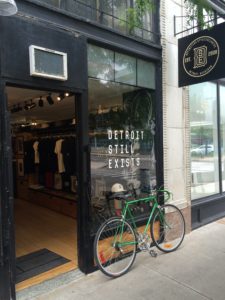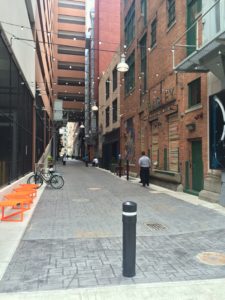Detroit Still Exists
I spent a few days last month in downtown Detroit at CNU 24. CNU is smart enough to host their annual “congress” in and around the city. We spent not a single moment in a conference center, but rather in beautiful old theaters, bars, parks, pop-up event spaces with food trucks, tables, vendors and Ping-Pong, and informal gathering spots. In other words, out in the city. Between walking to and from my hotel to various conference events, I observed and soaked up quite a bit of downtown life. I have to say, I’m very impressed. Detroit’s public realm and remaining building fabric provide a strong basis for a strong city in the future. The crazy thing is downtown Detroit has elements that supposedly much stronger downtowns lack. The following is my list of Detroit envy.
First, Detroit still exists. In fact, it has created a cottage industry has been based on its demise. And why not? This funky little downtown storefront (below) sells civic pride. Since this store opened, dozens of additional vacant storefronts have been filled. While many more spaces remain vacant, each new business that opens adds to the urban vitality of the streets of downtown Detroit.
Woodward Avenue is the “Main Street” of downtown. Despite the loss of the grand Hudson’s store, leaving a huge gap in the downtown streetscape, the street retains tremendous potential, primarily due to wide sidewalks with boulevard trees and remaining buildings that have a high GDA. Not rocket science, just the bones of a good street that may be great again, particularly when streetcar service begins in 2017. (Note, Hudson’s was demolished in 1998 and replaced by, you guessed it, parking. However, the parking is located underground with infrastructure in place to construct a new building. Some day.)
Downtown Detroit today offers numerous restaurants. Several formal (and countless informal) CNU events were held at Detroit Beer Co., with the view from the sidewalk showing all the classic ingredients of people-friendly places – good frontage, food and drink, places to sit, classic signage, a little history, and walkability. This sidewalk seating has the added perk of the kitschy but effective Detroit People Mover passing above (“monorail, monorail”).
This alleyway in Detroit has shades of Melbourne, with retailers facing it and other placemaking amenities such as bike racks and lighting strung across the alley.
Joe Riley, former mayor of Charleston, South Carolina spoke at CNU. A great urbanist, one of his best quotes is “The public realm is the part of our city that belongs to all of us, that gives us our identity.” Campus Martius is an excellent example of a wonderful public space that gives Detroit an identity, and is deserving of its own post about how to build and manage a downtown park. With its main area measuring less than two acres, it is the right scale for activity and rubbing elbows, with a fountain, a restaurant, sand box for kids to play, plentiful seating, plentiful shade, a lawn, stage, monument, and space for food trucks.
“The things we value most are the things we own together.” That’s Joe Riley again. The photo below shows my vantage point from a quiet place in Campus Martius where I sat for some time, peacefully people-watching, my back to the dripping water wall that drowned out the sound of traffic just a few feet behind me. I was struck by the diversity of the park patrons when I visited, enjoying that which we own together.
“Public spaces are where citizens can go to bathe themselves in peace and beauty.” Guess who? Joe Riley. Besides Campus Martius, downtown Detroit is blessed with numerous green public spaces. Most are small, most offer shade and seating, some in the median of a boulevard, others carved out of blocks created by the street grid that radiates outward from downtown at many angles and directions. My favorite little park is Harmonie Park (shown below), an intimate, wedge-shaped park on the east side of downtown. You can approach it from a number of directions and pass through or walk it’s edge. Or sit for a while, as I did one evening between events, taking a moment to bathe in peace and beauty. The crosswalk to Harmonie Park (below) is an example of playful placemaking and one of several downtown crosswalks with a similar treatment.
Downtown Detroit has some beautiful historic building interiors that shouldn’t be missed. The lobby of the Guardian Building is a must-see for any visitor.
Joe Riley’s best-known quote is “There is no excuse to build something that doesn’t add to the beauty of the city.” This advice rings true, whether it is a signature project or where you take a lemon and make lemonade. This fugly parking structure is saved by a coffeeshop, which not only holds the corner but adds pedestrian activity and good frontage.
Vacant land exists where buildings have been demolished, some being replaced by community gardens and cafes.
Having fallen so far, the building stock of downtown Detroit contains dozens of still-vacant buildings that present opportunities for additional housing, hotels and office space, in addition to ground floor retailers and other activity.
What is next for Detroit? No doubt the city faces huge obstacles moving forward, like solvency. Downtown has recovered to perhaps just half of what it once was in terms of life, activity, population, employment, etc., but in so many ways it is a better place than a number of other downtowns I can think of around the country. Downtown Detroit has an excellent public realm with wide sidewalks and parks (I haven’t even mentioned the beautiful waterfront), and is lined with old buildings (some of which no doubt survived because the city was too broke to tear them down, the market too poor to replace them) with great frontage that is today accommodating new generation of retail tenants. A great example is this little restaurant that enlivens an otherwise blank side of a building.
And I couldn’t help but notice they have no skyways – everyone shares public space. Plus, people obviously care about the future of the city and are using this existing public realm (that which we all share) to create great places. Detroiters are doing simple things like painting funky crosswalks, hosting events in parks, bringing in food trucks and planting community gardens. Most of all, they are building things that add to the beauty of their city.
Those of you who thought Detroit rolled up its sidewalks and is just…gone…poof, you are wrong. Detroit proves that good urbanism isn’t rocket science. So placemakers and urbanists take note: Detroit still exists. And it has a lot to offer.
No Comments »
No comments yet.
RSS feed for comments on this post. TrackBack URI
Leave a comment
Line and paragraph breaks automatic, e-mail address never displayed, HTML allowed: <a href="" title=""> <abbr title=""> <acronym title=""> <b> <blockquote cite=""> <cite> <code> <del datetime=""> <em> <i> <q cite=""> <s> <strike> <strong>












